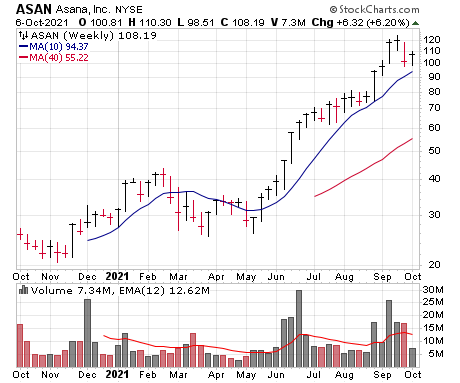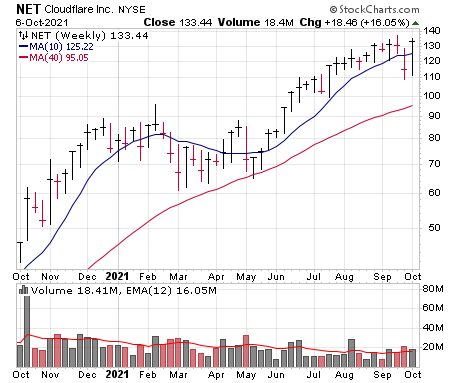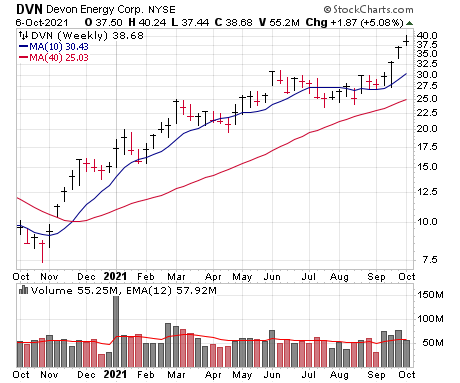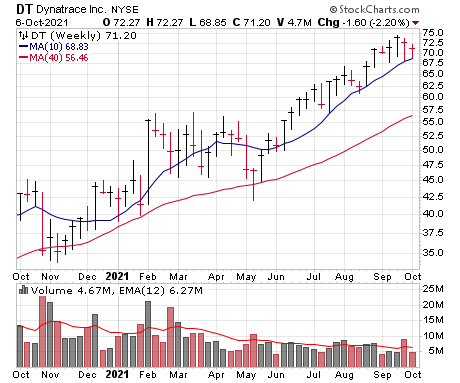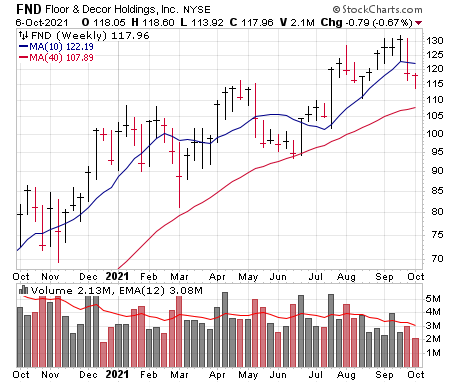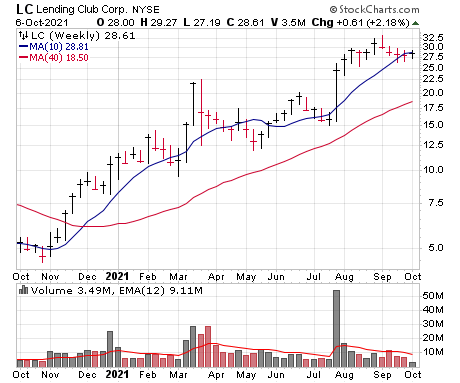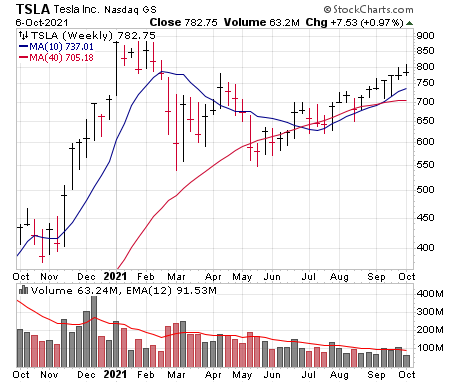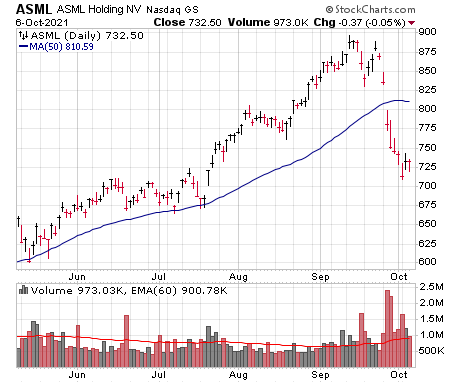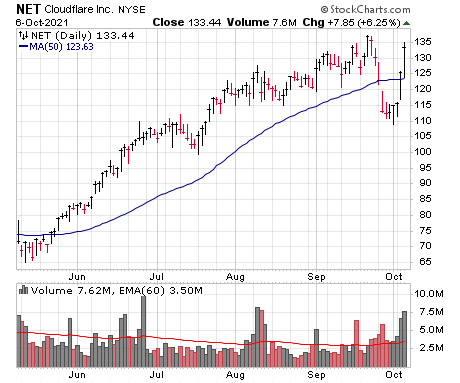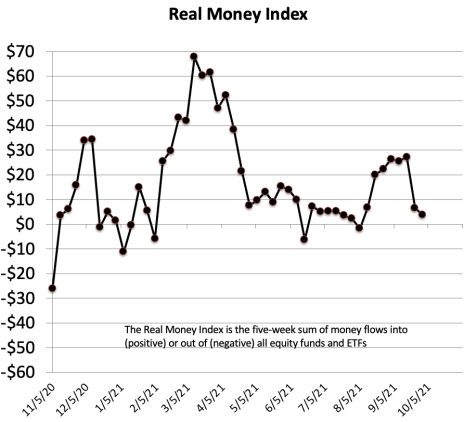The market’s correction is about a month old, and so far it’s been fairly garden variety, with some potholes but not much big-picture abnormal action. And, this week, we’re seeing a very encouraging bounce, with most indexes recouping half of their decline in just two days and some growth stocks already testing new high ground. We’re not out of the woods yet, but we’re holding what we own (some of which act great) and fine-tuning our watch list should the trend turn back up.
Cabot Growth Investor 1482
[premium_html_toc post_id="238891"]
Encouraging Bounce, but Need to See More
We’re now about a month into this market correction, which to this point has been relatively garden-variety—from the high in early September to its low earlier this week, the S&P 500 slipped 5.9%, while growth-oriented indexes did a bit worse (Russell 2000 Growth down 7%, Nasdaq down as much as 8%, etc.). And individual stocks are in a similar boat, with many cracking intermediate-term support but few showing any longer-term abnormal action.
In the last issue, as the market was bouncing after its initial crack, we wrote in a few places that such a decisive breakdown (on September 20, when the Cabot Tides first turned bearish) usually has reverberations. Sure enough, we saw a second leg down soon after and now we’re in the midst of another bounce. But, frankly, this rebound looks far more encouraging—many resilient growth stocks have perked up, some that looked iffy (like Cloudflare) have stormed back on giant volume, and the major indexes have quickly recouped about 44% of their month-long declines.
Moreover, after months of complacency, we’re finally seeing signs that investors are getting worried (a positive from a contrary point of view). The AAII survey, for instance, is showing its least amount of bullishness since last September, while Investors Intelligence (the grandaddy of surveys) has its fewest percentage of bullish advisors since April 2020. More important, investors are beginning to flee in real money terms, with sizable outflows the past two weeks.
Bigger picture, the action during the past month—some pain but nothing outrageous, and with many throwing in the towel amidst a torrent of bad news—plays into our thought that this is a correction within an ongoing bull trend. Thus, we’re not advising selling wholesale and we think it’s best to hold your resilient growth names (and it’s OK to do a little buying here and there, too).
But near term, we see it as more of a coin flip: Could we have seen the bottom? Sure, it’s possible, especially for growth stocks given that so many have already had one or two deep consolidations this year. But we need to see more to conclude the correction is over—even after the bounce, the market’s intermediate-term trend is still down, and most stocks are in the same boat.
What To Do Now
Thus, for now, we’re content to do nothing—we’ve pruned our worst stocks during the past month and are sitting with 44% in cash, but we’re not anxious to sell any of our remaining names and continue to fine-tune our watch list. From here, it’s a matter of taking what comes: A Tides buy signal and some growth stock breakouts will have us buying, but right now the market still needs to prove that this rally is the real McCoy. We have no changes tonight.
Model Portfolio Update
The market correction that began a month ago is still technically in force, with even the formerly impenetrable big-cap indexes still living below intermediate-term support. As always, we won’t anticipate what comes next. As we wrote above, we’re encouraged to see some real worry seep into sentiment, which effectively reloads the bullish cannon for when the next advance gets underway. And it’s not difficult to find growth stocks that are still hanging in there—as opposed to last February/March, when growth was trashed, there’s definitely some resilience out there.
Because of that, we’re trying to give our stocks a chance to hold up, but until proven otherwise, we consider the intermediate-term trend to be down, so you should hold a good chunk of cash and fine-tune your watch list for the next upleg. We’ll be on the horn soon if this rally proves itself in the days ahead.
Current Recommendations
| Stock | No. of Shares | Portfolio Weightings | Price Bought | Date Bought | Price on 10/7/21 | Profit | Rating |
| Asana (ASAN) | 1,354 | 7% | 73 | 7/22/21 | 109 | 50% | Buy a Half |
| Cloudflare (NET) | 1,790 | 11% | 113 | 6/25/21 | 137 | 21% | Hold |
| Devon Energy (DVN) | 7,240 | 13% | 28 | 5/7/21 | 38 | 37% | Buy |
| DocuSign (DOCU) | — | — | — | — | — | — | Sold |
| Dynatrace (DT) | 3,114 | 11% | 65 | 8/6/21 | 72 | 10% | Buy |
| Floor & Décor (FND) | 1,845 | 10% | 111 | 4/9/21 | 120 | 8% | Buy |
| ProShares Ultra S&P 500 (SSO) | 871 | 5% | 60 | 5/29/20 | 125 | 109% | Hold |
| CASH | 949,556 | 44% |
Asana (ASAN)—ASAN took the initial portion of the market’s downturn in stride but, as with many names, the latest leg down did damage, dropping the stock back toward the century mark. Given the huge prior run, shares are far from broken (after the recent bounce, shares are actually back above their 25-day line), which is encouraging. And another good sign is the continued bullishness of the firm’s CEO—on Tuesday, he bought 477,000 shares or so (executed a price of 100, so that’s nearly $48 million worth!), bringing his holdings to 5.2 million shares. To be clear, it’s much more important what big institutions think of a stock, as they’re the ones that move it around over time, but it doesn’t hurt perception to know the grand poohbah is gobbling up shares on weakness. Overall, just going with the evidence, we have a stock that’s pulled in sharply, but has bounced and remains in an uptrend, with a fundamental story that’s gaining steam thanks to its best-in-class cloud work-management platform. We have our eyes peeled in case the sellers reappear, but if you own a half position, we’d hold on, and if you don’t (and already have plenty of cash), we’re OK snagging a half-sized position around here or on dips. BUY A HALF
Cloudflare (NET)—As we write about later this issue, we’re seeing more stocks that have flashed bearish volume clusters right off their highs, and NET was one of them, falling nearly 20% in a straight line on a few days in a row of big volume. But the action this week has been abnormal in a good way, with shares recouping 90% of their decline in just a couple of days—and both days saw volume larger (more than double average volume) than any on the decline! Now, we can’t definitively say that the stock is out of the woods, but the strength of a bounce after a sharp decline is usually telling, so the action is a great sign that NET will remain a leader if the market’s correction ends in the relatively near future. Fundamentally, nothing has changed here, with demand for the company’s content delivery and security solutions (including its recent move into email security, which is a big niche) set to grow rapidly for many years to come. We’ll stick with our Hold rating for a bit longer to see if this rally sticks, but we wouldn’t argue with a small purchase if you don’t own any. HOLD
Devon Energy (DVN)—DVN has been a star performer of late, breaking out above 31 or so and zooming to 40 in just a few sessions before a little profit taking the past two days. Obviously, the run in energy prices (oil is now around $78, while natural gas is in the $5.50 area) has been a driver, but as we write later in this issue, we also think investor perception is slowly coming around to the view that DVN (and some of its peers) are going to be durable cash cows, too. Of course, commodity stocks are always tricky and there will eventually be oversupply, but after years in the doghouse, we think the sector as a whole is in a bull market—and, most important to us, Devon looks like one of the top leaders in the group. If you own some, we advise sitting tight, and if you don’t own any, you can start with a small-ish position here or on dips of another couple of points. BUY
DocuSign (DOCU)—DOCU has also bounced decently the past couple of days, but the stock is still buried, as it’s just now kissing its declining 25-day line from below and is still stuck well below resistance in the 280 to 300 zone. As we mentioned previously, it wouldn’t shock us if the stock’s action since September 2020 (when it initially topped) morphs into one giant launching pad given the continuous rapid growth of its e-signature and Agreement Cloud offerings. That said, something has clearly spooked the buyers, with the stock topping out well ahead of the market and not showing much excitement yet. We cut bait last week and are holding the cash. SOLD
Dynatrace (DT)—We’ve written before about how Dynatrace had been acting well, yes, but it’s also acting “under control,” which is usually a sign that there are few weak hands in the stock (or, if there are, they’re being swamped by strong institutional buyers). Indeed, so far, that’s played out, with DT failing to even touch its 50-day line during the market correction and, today, tested all-time highs. Obviously, good stocks can go bad in a hurry, so if the market goes over the falls again, all bets are off. But the initial reason we took a position in DT still holds: We view it as rare, dependable merchandise in the cloud wars, with a best-in-class platform that’s perfect for huge enterprises that are transitioning so many apps, departments and functions to the cloud. (It also doesn’t hurt that options activity has been bullish in the stock of late, a sign smart money is accumulating shares.) We’ll stay on Buy, though a dip of a couple of points could offer a better entry. BUY
Floor & Décor (FND)—As of yesterday morning, we were set to place FND on Hold given the fact that the normal-looking retrenchment early last week gained steam, driving shares into the mid-110s. But as with so many names, the stock’s rebound the past two days has been very impressive, recouping half of its sharp decline in just the past two days. It’s far from out of the woods (the 50-day near 123 will be a barrier), but it’s been in the stock’s character to have deep, tedious pullbacks only to emerge to new highs soon after. If this bounce rolls over in a hurry, we’ll move to Hold and likely use a mental stop a couple of points below the recent lows (110 to 112 area), but right here, we’re going to again stick with a Buy rating, thinking there are decent odds the recent dip was more of a shakeout than a lasting top. BUY
ProShares Ultra S&P 500 Fund (SSO)—SSO fell nearly 12% from high to low, which isn’t pleasant but definitely not crazy following its massive run in recent months, and of course the recent bounce has been solid. Another bout of weakness wouldn’t shock us, which is why we sold half our stake on the initial breakdown on September 20. But our thoughts with this leveraged long index fund are the same as the overall market: The intermediate-term trend is still iffy at best, but the long-term trend is up, and many one-off studies show the likelihood of a continuing bull market in 2022 to be strong. A break of the 200-day line (near 112) may change our thinking, but if you took partial profits and have a big gain on your remaining shares, we advise sitting tight. HOLD
Watch List
- Affirm Holdings (AFRM 134): AFRM has every reason to get nailed during a market correction, but instead, it’s actually pushed to higher highs as it signs up new major partners (Target was the big fish this week). It’s a hot potato but the potential is massive.
- Ambarella (AMBA 159): AMBA pulled in nearly 25 points, but that came on the heels of a 70-point post-earnings move; indeed, shares are still north of their 25-day line. It’s very likely the firm has just begun a multi-year period of surging earnings thanks to its computer vision chips.
- Dexcom (DXCM 539): DXCM is more of a liquid leader than a glamour name, but that’s fine by us—shares have taken on some water but are still near their 50-day line, which is heroic in this environment.
- Paycom Software (PAYC 512): Similar to DXCM, it’s unlikely that PAYC will light the world on fire, but it’s emerged from a big consolidation and should see earnings advance in the 25%-ish range for a long time to come as its HR solutions (and new offerings) take hold.
- Snowflake (SNOW 320): SNOW has fresh leader written all over it, with ridiculous growth in sales and other sub-metrics (like remaining performance obligations). The stock is perched near its highs.
Other Stocks of Interest
Coinbase (COIN 252)—We’ve purposely stayed away from most cryptocurrency stuff, largely because the ways to play that sector (from ETFs to small mining operators) didn’t fit our growth criteria. But we’re starting to see a few that do, and the one that intrigues us is Coinbase. It looks like the #1 Bull Market stock in the sector, billing itself as the leading provider of end-to-end financial infrastructure for the crypto-economy, even comparing itself to Google in the early days—but instead of democratizing information through search, it’s enabling anyone to own, invest, spend and earn crypto assets. Yes, a lot of this is retail money, but institutional whales are using the firm’s platform as well thanks to its trading, custodial and security technology. The result is a business that’s surging at rates that are almost hard to comprehend: Overall trading volumes in Q2 totaled $462 billion, up from just $28 billion the year before (and up from $335 billion the prior quarter), with institutions making up 69% of all volumes and total transacting users totaling 8.8 million (up from 6.1 million the prior quarter). (Half of all trading is Bitcoin and Etherium, with all other crypto assets making up the other half.) Also impressive is the bottom line, which has been solidly profitable for many quarters and is expected to total nearly $12 per share this year! Of course, easy come can turn into easy go—Wall Street sees business slipping in a big way next year (earnings off 48%) as crypto cools and spending picks up, but as with any Bull Market-type stock, those guesstimates can change dramatically based on the environment. The stock appears to be waiting for some clarity on that situation, too: After coming public with a lot of hype, COIN plummeted to 208 and has since gyrated in a wide, bottoming range. It’s not ready for primetime here, but it’s big, it’s liquid, and if you think crypto has a bright future, it’s only a matter of time until COIN has a sustained run. We wouldn’t buy it here but it’s worth keeping an eye on.
LendingClub (LC 30)—We’re not sure of the exact phrasing, but there’s an emerging theme in the market that involves easier personal loans—whereas most had to hit up their buddy or local bank in the old days, we’re now seeing firms offering people flexibility with borrowing and payments. Yes, there’s always risk if the economy heads south, but the potential is big. Our favorite idea in the space remains Affirm Holdings (AFRM), which we wrote up in the previous issue and is on our watch list, but LendingClub is another name to look at: It’s the largest peer-to-peer online lending marketplace and, thanks to its acquisition this year of Radius Bancorp, is a full-spectrum fintech bank in the U.S.. People often use the platform to borrow money in order to fund a major purchase or refinance higher-coupon credit card debt, though LendingClub offers much more than that and is now able to fund some of those loans via low-cost deposits. Plus, its deep user base (more than 3.5 million members) and data reserves gives it a leg up on the competition in terms of picking reliable borrowers to approve. The firm was always a small fry, but it looks like the move to a bank (and more reliable net interest income) has changed everything—in Q2, loan originations were up 84% from the prior quarter (its loan portfolio is now $2.4 billion), driving sales up 123% and earnings were in the black and well above expectations. It’s important to note this isn’t a tiny outfit anymore—for the full year, management meaningfully hiked guidance and sees $10 billion-ish of loan originations, while revenues are likely to grow 146% this year and 41% next. The stock was a nothingburger for years, but picked up steam in late 2020, and the coming out party came on earnings July 29, with a 48% gap on 17 times volume! LC has pulled back with everything else, but remains in fine shape overall. You shouldn’t invest the rent money in this stock, but the longer it can hold up around here, the greater the odds of another leg up when a new market uptrend gets going.
Tesla (TSLA 794)—TSLA was a huge leader from late 2019 through January of this year, so it’s possible it’s hit a point of peak perception. But it’s also possible that the 37-week, 40% deep consolidation since that high will serve as a launching pad as the electric vehicle revolution accelerates. The story isn’t a secret, so we won’t rehash it all, but here’s why we’re keeping tabs on it. First, despite the endless controversy surrounding the firm, the numbers here are hard to beat: Sales growth is accelerating (46%, 74%, 98% the past three quarters), current (up 230% in Q2) and estimated earnings (up 134% this year and another 39% next) are booming and this doesn’t look like peak growth, with management stating that they anticipate growing capacity by 50% annually (!) during the next many years as demand for its Y, X, S and 3 Models soars. Throw in upside from the solar and battery storage business (deployments of both tripled in Q2 from the pandemic-impacted year-ago quarter) and there’s every reason to think Tesla is going to grow profitably for many years to come—and while it won’t be the young buck it was once, and competition will be watched, we think there’s a reasonable chance the stock could morph into more of a liquid leader as it’s likely to remain at the very least the dominant luxury EV producer. Moreover, the stock itself is slowly rounding into shape, advancing nine of 10 weeks since mid-July, a sign of persistent buying. There’s still resistance near 800, so we can’t say TSLA is ready to blast off, but the longer it can act well in this tough environment, the greater the chance that the past nine months will lead to solid upside.
The Energy Bull Thesis Continues to Play Out
We remember many years ago owning Equinix (EQIX), which at the time was “only” a fast-growing builder of data centers, demand for which was increasing year by year as everything went digital. But what attracted us to the stock was a special situation: The company was transforming to REIT status, which would make the company far more tax efficient and lead to income for shareholders. As the REIT plan moved forward, investor perception improved, driving the stock to nice gains.
Today, we see a similar situation with many energy explorers. In the intermediate term (next few quarters), we think the industry is likely to behave itself because of the recent past: For years, explorers spent and borrowed like mad to expand production as rapidly as possible (and pipeline companies did the same to transport all the oil and gas being pulled out of the ground), but interestingly, the stocks were never fully rewarded for that. Plus, of course, the breakneck pace left many exposed to a down cycle, which the industry suffered from 2018 through 2020.
But the upside of that huge spending spree is that many firms had acquired lucrative acreage positions in some top-notch basins, and there was plenty of takeaway capacity in those areas too. Companies realized they could slash exploration costs, keep output relatively steady and rake in ridiculous amounts of cash flow even at modest energy prices ... which is happening now.
While the stocks are due for some retrenchment, we think the cash flow story is under-appreciated: The strongest players are likely to be cash cows even at $50 to $60 oil prices, and with so many having already slashed debt levels, much of that will be returned to shareholders via dividends or share buybacks.
Devon (DVN) is our favorite and is doing very well. It’s already slashed its debt load (debt will be less than one times EBITDAX by year end; no maturities until 2023; 60% of debt matures after 2030 anyway), and it was the first to implement a fixed-plus-variable dividend plan. At $70 oil and $3.50 natural gas, the firm’s free cash flow will likely total $2.50 per share in the second half of the year (55% to 60% likely to be paid out), and thanks to merger synergies and money-losing hedges falling off, it sees an incremental $1.30 per share in free cash flow (all else equal) in 2022 on top of whatever it earns this year.
Pioneer Natural Resources (PXD) is following a similar script as Devon: Having already cut costs to the bone, it implemented a fixed-plus-variable dividend payment system ($2.07 per share total just for Q2). But management is thinking longer-term here: With 5% production growth and $60 to $70 oil, it believes it could pay out north of $3 billion in dividends each year (about a 7% annual yield) for the next five years.
Continental Resources (CLR) is taking a different path—it has boosted its base dividend a couple of times this year (annual yield 1.1%), but it sees free cash flow coming in around $2.4 billion this year alone (13% of the current market cap) and has $680 million left on a share buyback program, which amounts to more than 20% of the stock’s float! All three names have been pushing to new highs of late.
To be clear, we’re not suddenly going to be oil-heavy investors; at day’s end, the companies in this group still have a lot of their fate tied up in things outside their control (energy prices), which means big investors are quick to pull the plug when things go south. But we think the tremendous cash flows, share buybacks and dividends will prove more durable than expected, which in turn should boost investor perception over time. Near term, pullbacks are likely, but the longer energy prices remain elevated, the greater the chance the group will enjoy a sustained move.
Bearish Volume Clusters off All-Time Highs
As opposed to the powerful breakouts from multi-month bases in many oil names, we’re seeing a number of bearish volume clusters among stocks that have had good runs in recent months. A few days of heavy selling doesn’t mean a stock is going to zero, but when you see (a) a decisive breakdown (b) on a few days in a row of heavy volume that occurs (c) right near a stock’s high, odds are good that an intermediate-term top is in.
One “good” example from earlier this year was Twilio (TWLO), which after a big run, got very sloppy in February and then, in early March, cascaded four straight days on big (average of 64% above-average volume); in fact, the stock had three straight weeks of huge volume right off the top, a clear sign big investors were exiting. Yes, there have been bounces, but that volume cluster area on the chart never gave way—today the stock is sitting 29% off its high and below even its 200-day line.
A more recent example from the latest selloff is ASML (ASML). The leading chip equipment maker had a huge run, but look at that selling in late September. And, while the best growth names have ripped back toward their old highs, this one has recouped less than a quarter of its decline.
However, while the volume cluster is important, it really comes down to how the stock reacts on the ensuing rally; usually those rallies are capped, but when they’re not—when buyers storm back on the scene—it’s usually telling you something. That may be what’s going on with Cloudflare (NET): Check out the five days in a row of heavy selling right off the top, which certainly raised the specter of a meaningful top. But this week’s action has been amazing, with a massive-volume rebound (both days were more than double average volume) and the stock actually tested new high ground today. Another wiggle isn’t out of the question, but if NET can hold these gains, the odds favor this being one big shakeout that paves the way for higher prices. HOLD
Cabot Market Timing Indicators
While the latest bounce is encouraging, the Cabot Tides sell signal is still in effect, and most individual stocks have a lot of overhead to chew through. We like the worsening sentiment and positive long-term trend, but we advise staying close to shore as we watch to see if the rally can prove itself from here.
Cabot Trend Lines: Bullish
The Cabot Trend Lines have backed off some, but they’re still clearly positive—the S&P 500 (by 4.5%) and Nasdaq (by 3.9%) are still holding north of their key 35-week moving averages as of mid-day today. We need to see two straight weeks of both indexes closing below their 35-week lines for a fresh sell signal, so there’s still wiggle room (in both time and price) before that comes. Right now, the major market trend remains up.
Cabot Tides: Bearish
Our Cabot Tides remain stuck in the bearish camp, with most indexes sitting beneath their lower moving averages. Some indexes, like the S&P 400 MidCap (shown here), are definitely more sideways than down, but even after this week’s bounce, most are “only” back up into key resistance. Until we see upside confirmation, we consider the intermediate-term trend to be down.
Cabot Real Money Index: Neutral
Our Real Money Index is starting to show some investor discomfort, with the five-week sum of money flows into equity ETFs and funds dropping back toward zero as the market has corrected. A couple more weeks of outflows or a big (-$15 to -$20 billion) weekly retreat would present a solid contrary sign. Right now, though, the indicator remains in the middle of its multi-month range.
Charts courtesy of StockCharts.com
The next Cabot Growth Investor issue will be published on October 21, 2021.
Cabot Wealth Network
Publishing independent investment advice since 1970.
President & CEO: Ed Coburn
Chief Investment Strategist: Timothy Lutts
Cabot Heritage Corporation, doing business as Cabot Wealth Network
176 North Street, PO Box 2049, Salem, MA 01970 USA
800-326-8826 | support@cabotwealth.com | CabotWealth.com
Copyright © 2021. All rights reserved. Copying or electronic transmission of this information without permission is a violation of copyright law. For the protection of our subscribers, copyright violations will result in immediate termination of all subscriptions without refund. Disclosures: Cabot Wealth Network exists to serve you, our readers. We derive 100% of our revenue, or close to it, from selling subscriptions to our publications. Neither Cabot Wealth Network nor our employees are compensated in any way by the companies whose stocks we recommend or providers of associated financial services. Employees of Cabot Wealth Network may own some of the stocks recommended by our advisory services. Disclaimer: Sources of information are believed to be reliable but they are not guaranteed to be complete or error-free. Recommendations, opinions or suggestions are given with the understanding that subscribers acting on information assume all risks involved. Buy/Sell Recommendations: are made in regular issues, updates, or alerts by email and on the private subscriber website.
Subscribers agree to adhere to all terms and conditions which can be found on CabotWealth.com and are subject to change. Violations will result in termination of all subscriptions without refund in addition to any civil and criminal penalties available under the law.

